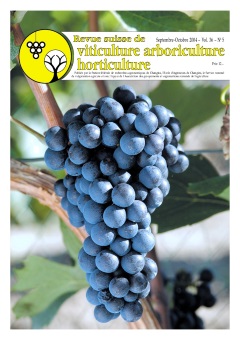
Issue 5 - September - October 2004
Abstract in open access
A test aiming at comparing the agronomic and enologic performances of vines produced by herbaceous grafting and traditional grafting was set up on the experimental vineyard of Agroscope RAC Changins at Pully (VD). The experimentation was conducted with the varieties Chardonnay, Gamay and Pinot noir. Except for the diameter of the trunks, in particular during the first years of culture, the vines resulting from the two types of grafting practically didn’t show any difference at agronomic, analytical and organoleptic levels. The green grafting did not induce any increase of the vigour of the stocks.
Key words: grapevine, green grafting.
Keywords:
E-Mail: dominique.maigre@bluewin.ch
Adress: Agora
Abstract in open access
Different organic nitrogen fertilisers were tested in 2001 and 2002 in sage, balm and basil. Three trials were conducted in mountain areas and one in flatlands to analyse their effects on yield and soil nitrogen. The aim was to find alternatives to the prohibited fertilisers with meat or blood meals.
The soil analysis made in the laboratory showed that mineral and mobilised nitrogen, as well as the potential of nitrogen mineralisation, were positively influenced by fertilisers even if there was only small differences between the different treatments.
In the field experiments, Castor Cake and Biorga N gave the best results. The yields with both fertilisers were similar to those obtained with the meat or blood meal fertilisers. The effect of Biorga Vegi and Optisol universel varied within the trials. Vinasse and the combination slurry-Biorga N gave the worst results.
According to these results and the comparison of the prices of the fertilisers, both organic nitrogen fertilisers Biorga N and Castor Cake can be recommended for the organic production of aromatic and medicinal plants as replacement for the prohibited fertilisers containing dried meat or blood.
Key words: aromatic plants, nitrogen fertilisation, organic farming, yield, soil nitrogen.
Keywords:
E-Mail: christoph.carlen@agroscope.admin.ch
Adress: Agora
Abstract in open access
Cold storage of Braeburn apples in controlled atmosphere with low oxygen (LO 1,5%) and 1% carbonic gas allows reducing brown heart disease and keeping a good firmness of the fruits. The results also depend on harvesting date and of fruit calibre. This variety gives off much carbonic gas in cold rooms with controlled atmosphere. An oversize scrubber is recommended to maintain the carbonic gas rate at 1% and a nitrogen rinse is needed after the coal regeneration phase to avoid increasing the oxygen rate.
Key words: Braeburn, storage, apples, controlled atmosphere, LO, CO2, O2, firmness, quality.
Keywords:
E-Mail: jean-pierre.siegrist@acw.admin.ch
Adress: Agora
Abstract in open access
Between 2000 and 2002, tests were carried out at Agroscope RAC Changins, Centre of Cadenazzo (Ticino, Switzerland), on tomatoes cultivated in a greenhouse of 200 m2 comparing 9 organic substrates to rock wool. All substrates were comparable to rock wool as far as tomato production in kg/m2 was concerned. Differences resulted in the percentage of the drainage nutrition solution and in the compactness of the substrate. The best organic substrates resulted Agripan and Dutch Plantin.
Key words: tomatoe, substrate, soilless.
Keywords:
E-Mail:
Adress: Agora

 Download of full issue
Download of full issue
 Download article
Download article